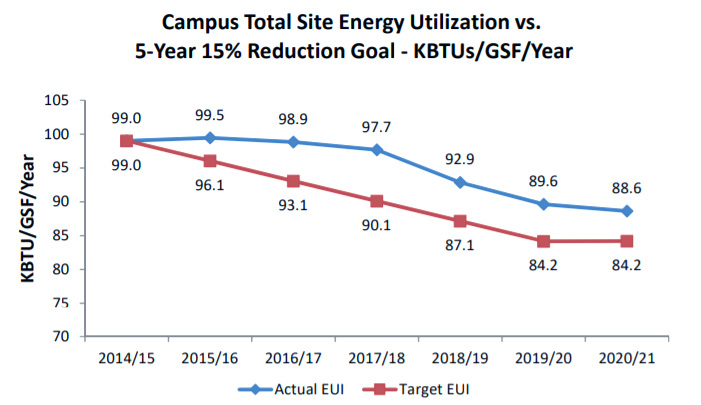Diversion, energy & carbon neutrality: sustainability and facilities look to the future
February 24, 2022
As the Campus Race to Zero Waste competition continues, Macalester’s sustainability department is re-evaluating their short and long-term goals. In collaboration with facilities, sustainability is assessing the college’s energy consumption and the costs of making sustainable improvements. Both departments are looking to increase communication with the student body and hope to help students better understand what steps are being taken.
In 2015, Macalester’s facilities department set a goal to decrease the school’s overall energy consumption by 15% over the next five years, at an average rate of 3% per year. To achieve this goal, the position of energy manager was created in facilities services, who would be responsible for increasing energy efficiency, specifically focusing on switching to more efficient lighting.
The goal of the energy manager position is to make energy conservation at Macalester a priority for one person, rather than a responsibility of several. This position is now held by Mike Pumroy, who was hired by the college in Sept. 2015.
Since the start of this objective, which used the fiscal year (FY) 2014-2015 as a reference for decreasing statistics, Macalester has seen a total energy reduction of 10.5%, with a 20% reduction in electricity. Furthermore, Macalester has improved their energy utilization rate (EUI) from being 6.8% lower than the median EUI to 29% lower than the median when compared to similar institutions.
“We are at record numbers on this campus as far as people that are consuming utilities at all times,” Assistant Vice President of Facilities Services Nathan Lief said. “We also have more square footage than we started with back in 2013-2014. There are a lot more devices sucking power at all times in our facilities and on our campus. And so even with those headwinds, we still made progress.”
A majority of the Macalester campus’ energy consumption comes from the heating plant, which accounted for 65% of the school’s total energy use and 85% of fuel use in the FY 2020-2021. In Feb. 2021, Xcel Energy requested an energy curtailment of the natural gas utilized in the heating plant. A curtailment is the reduction of a renewable resource’s output. This natural gas curtailment forced Macalester to switch to burning #2 fuel oil for a portion of the month and is estimated to have cost around $115k.
The college’s fuel use is also highly dependent on the weather. Each building on campus has a sub meter, which monitors consumption of various utilities, including electricity and gas use. This allows for comparison of heating days and fuel consumption, and helps facilities services understand whether Macalester is actually making progress in terms of energy consumption, rather than just fluctuations in outside temperature.
Due to the extensive lifespan of the boilers that Macalester uses to heat the school, it is not cost effective to replace them, as they currently have an estimated 30-40 years of use remaining.
“These are decisions about what to do with large, central plants,” Pumroy said. “These are multimillion-dollar infrastructure projects that kind of push you in a direction for a long period of time. Those boilers are designed to last for a minimum of 30 years and 50 years.”
Because of the fairly set nature of the college’s fuel consumption, the majority of Pumroy’s energy conservation efforts have focused on lowering the school’s electricity use.
Though the amount of energy use that stems from electricity is significantly less than that for fuel, the electrical costs are much higher. The electricity cost averages around double the fuel costs over the last seven FYs at around $1 million. The cost per kilowatt of electrical demand has increased by $2.40 since the FY 2014-2015.
In 2018, in order to offset the cost of electricity, Macalester entered into an agreement with Xcel Energy to purchase a portion of the energy produced by the school’s solar arrays. The solar panels can be found on top of Markim Hall, the Leonard Center, the theater building and the Ordway, Macalester’s natural history study area. This agreement dictates that the cost of the energy produced by the solar gardens is locked in place, as a hedge against future increases in electricity costs.
“It’s a payment that helps us finance the additional cost of putting that infrastructure on the campus,” Lief said. “We actually end up consuming just about all of the electricity that we produce on campus.”
In the FY 2020-2021, the energy produced via Macalester’s solar panels amounted to 38% of the yearly electrical consumption and saved the school approximately $39,000.
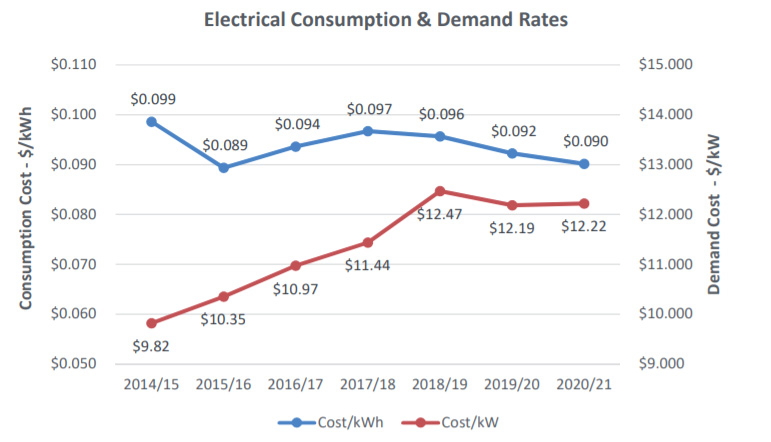
Xcel Energy is also undergoing changes to green their grid by building their own energy production via solar, wind and nuclear energy and by purchasing their energy from greener sources. As a result, even if Macalester’s energy consumption does not decrease, there is less carbon being produced in the production of the energy the school purchases.
“The greener they can produce the electricity the better it affects our numbers,” Lief said. “They’re generating less carbon work, and we’re consuming the same amount of power, which means we’re going to produce less or we’re responsible for less carbon.”
Due to the decreased numbers of students living on campus, the fourth quarter of the FY 2019-2020 and the FY 2020-2021 saw sharp drops in consumption of water and electricity.
“Last fiscal year was a really good year to be an energy manager,” Pumroy said. “The amount of utilities used by Macalester is really largely driven by occupancy. We were several $100,000 below budget last fiscal year. Now, this year, we’re using that up and then some.”
With fewer students on campus during the previous academic year, facilities services was able to reduce energy consumption down towards the baseline that it takes to operate the school. However, with the campus returning to full capacity during the 2021-2022 academic year, utility costs have shot up, specifically due to the need for increased air circulation to prevent the spread of COVID-19.
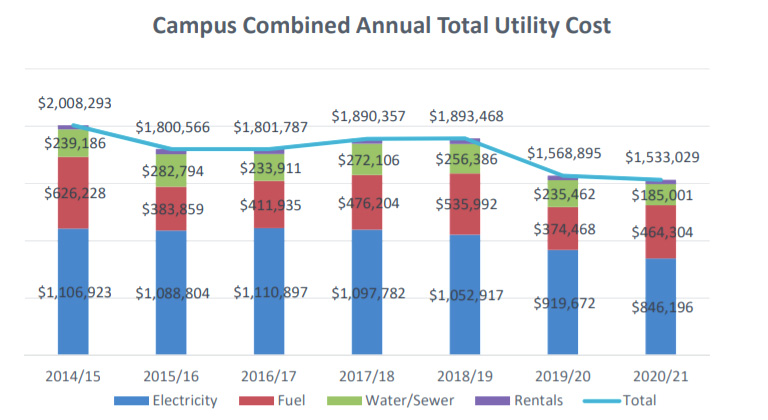
“This year with the occupancy we have, it’s really pushed our budgets above and beyond where they’ve been in the past,” Lief said. “Part of that is due to the pandemic, because we have doubled the amount of outside air that’s being brought into all the buildings to try and dilute virus in the air.”
Once the pandemic comes to an end, facilities hopes to work towards bringing their systems back towards the baseline they saw when the campus was empty. However, both Lief and Pumroy emphasized that this will only be possible if individual sacrifices are made, whether that be in comfort or convenience.
“I think that the student body is very concerned with this stuff, and believes in making progress, but I also think that a lot of the time, it’s only as long as it doesn’t negatively impact them in any way, shape or form or inconvenience them,” Lief said.
“There are always costs right for any progress that we’re gonna make,” he continued. “I think that is the message I would like people to understand, and then they can make informed decisions about the things that they do. Make it part of your everyday life.”
Both Lief and Pumroy emphasized that the purpose of facilities services is to not be seen. The better they are doing their jobs, the more invisible they become. As they increase in efficiency, repairs are less often seen, so everything around campus functions as it should. Because of this, they are hoping to increase student knowledge about the infrastructure on campus and what they can be doing to save resources.
“It’s hard in a campus environment for people to feel like their individual actions make a big impact because so many spaces are large, shared spaces,” Pumroy said. “Unfortunately in some of our own smaller spaces, offices and residence hall rooms, there’s not a lot of options other than just the light switch, and that doesn’t feel like much.”
Lief emphasized that even though they are working hard to increase the efficiency of the campus’ energy consumption, individual actions have a strong impact on overall reduction of consumption.
“If you don’t need to consume that utility or that light, then don’t use it,” Lief said. “I think that if we told people that more explicitly, they’d think a bit more before they just walk in and flip the switch on.”
Director of Sustainability Christie Manning echoed Lief’s sentiment.
“There’s personal responsibility, which is about campus engagement,” Manning said. “The infrastructure on campus makes it about as easy as it can be for people to live a fairly zero waste life on campus.”
Access to information regarding sustainability and energy use is something that the sustainability department is currently working on. Student sustainability workers have created maps that show where the different types of waste go after they leave Macalester, in order to help others gain an idea of the broader picture.
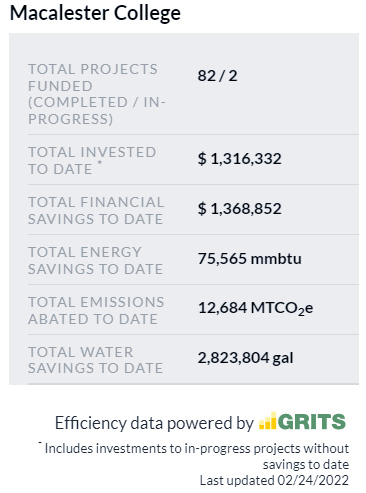
“We feel that there’s a lot of people who are interested in knowing where Macalester is at emissions-wise and zero waste-wise, but we’re not sure if the data is being communicated in the best way or if it’s behind a barrier,” Sustainability Student Worker Aaron Backs ’22 said.
In order to increase understanding, the sustainability office is overhauling its section of Macalester’s website.
“It’s really hard to engage everybody … This is maybe a symptom of being too busy,” Manning said. “It’s hard to cut through all the busyness in everybody’s lives to get their attention. Sustainability is about environmental justice, right? And it requires all of us to be engaged and to be doing what we can.”
Campus Race to Zero Waste
The Campus Race to Zero Waste is competition between colleges that provides the opportunity for schools to monitor, reduce and eliminate waste.
“The Campus Race to Zero Waste is an opportunity to learn and to engage the community around our zero waste efforts and aspirations,” Manning said. “It’s good that it comes up every year so we can keep track of what we’re doing well at and what we need to improve.”
In 2021, Macalester was ranked first in the diversion category of the Campus Race to Zero Waste, which was an improvement from 2020 when the school was ranked ninth. In addition, the college was a case study winner for waste minimization that year for its student-led SustainaCup program. However, this doesn’t necessarily mean that Macalester’s sustainability measures have become more successful. The diversion category, which Macalester has historically competed in, is a calculation of the compost-to-waste ratio.
According to Backs, the Zero Waste Data Manager in the sustainability department, the increased number of single-use disposable containers greatly inflated the compost produced by the school during the 2021 school year. However, the school’s waste production remained relatively steady.
“There wasn’t some massive behavioral shift that everyone started, like sorting more properly or reducing the amount of waste produced on campus,” Backs said. “The amount of waste we were producing didn’t change at all.”
The increased use of compostable containers caused distortion of the diversion rate for the 2021 school year, which doesn’t actually reflect tangible gains in sustainability for the college. As a result, for the 2022 competition, Macalester is entering itself into three sections for the race: diversion, food organics and zero waste categories.
“Both Manning and I feel that our mindsets of this isn’t about winning an award,” Custodial Services Manager Karen Maxwell said. “This is about really taking a true measurement of where we realistically are.”
Both Maxwell and Manning anticipate that the re-implementation of the reusable container program will cause Macalester’s diversion rate to fall due to a decrease in compost production. Since diversion no longer seems to be an effective evaluation of waste reduction and progress towards sustainable practices, the sustainability department is looking for another metric to better judge these goals.

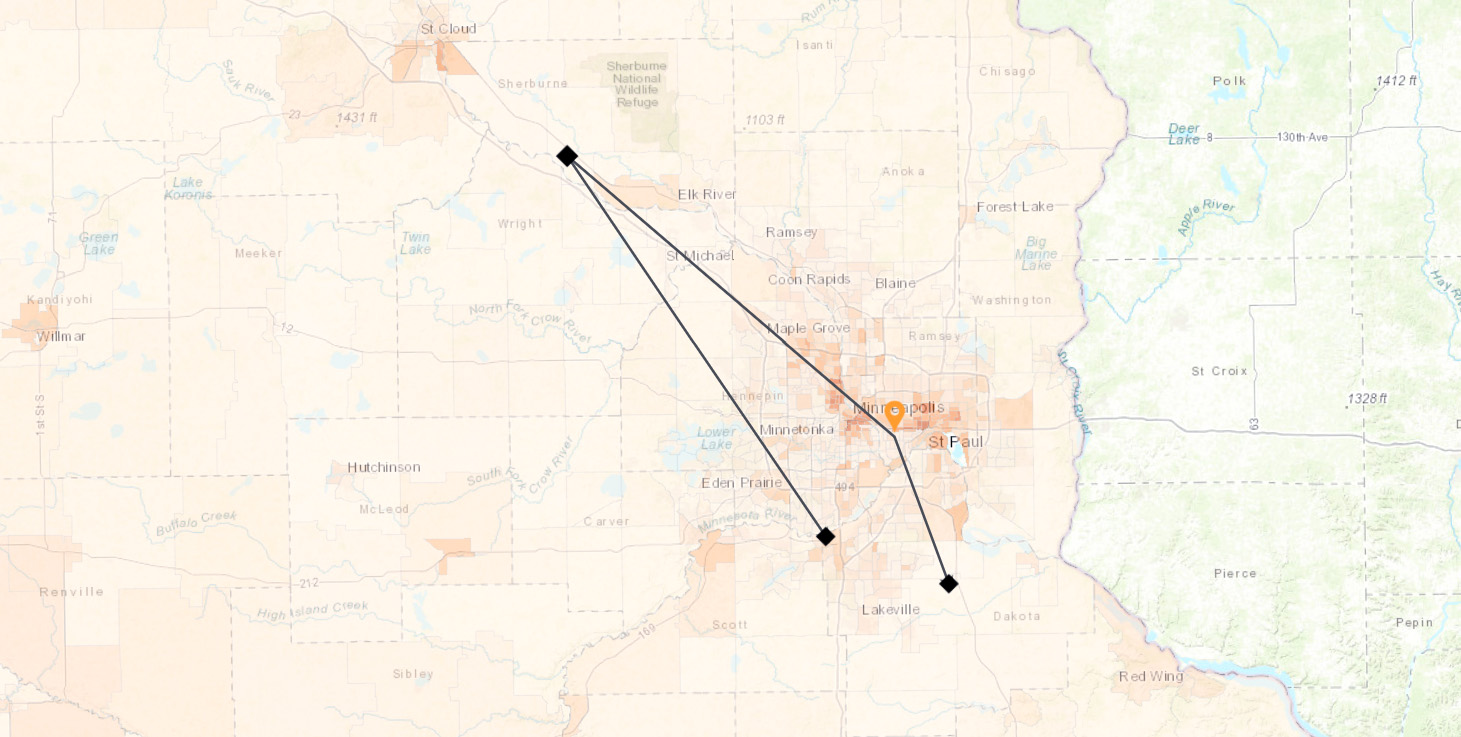
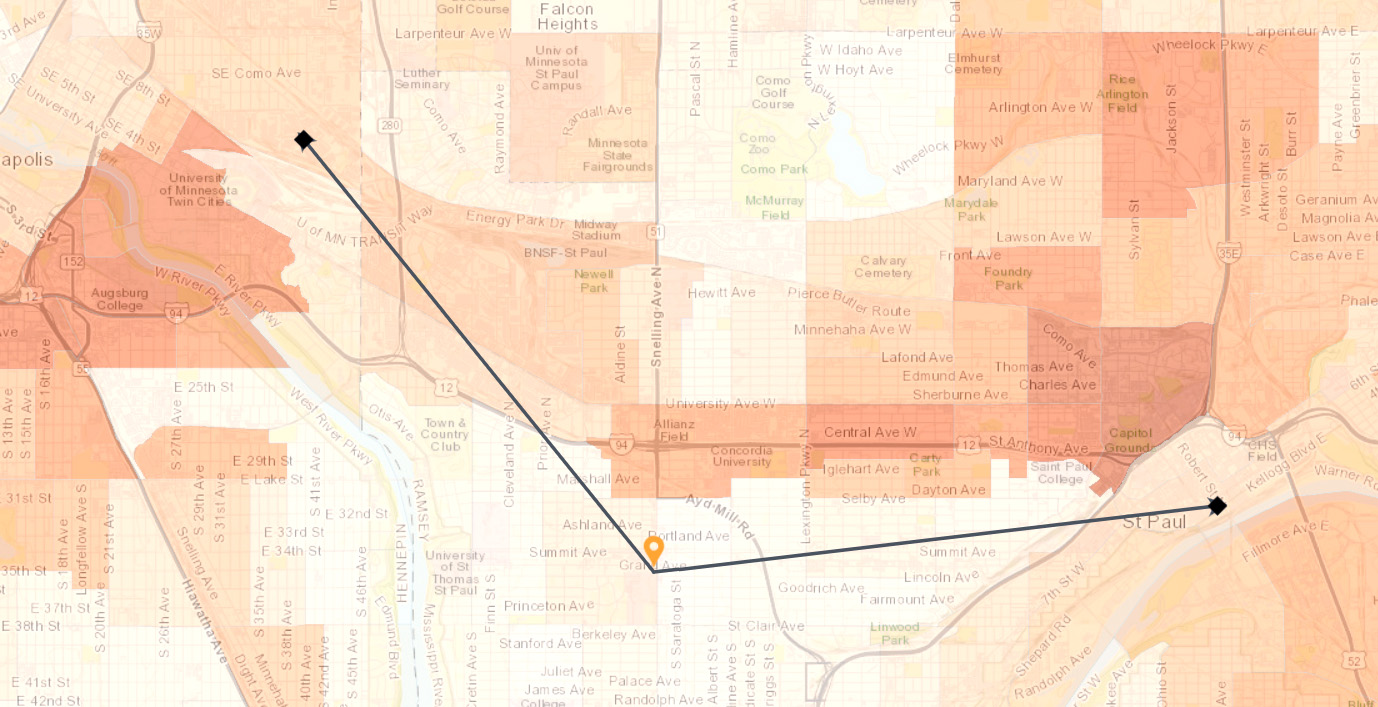
Atlas Zero Waste Fellowship
In order to re-evaluate what metrics Macalester uses to assess sustainability on campus, the Atlas Zero Waste Fellowship sent two students, Jeanarry Rodriguez ’24 and Susanna Deal ’25, to look at zero waste initiatives holistically and determine a better way to measure sustainability than diversion.
“They’re working with the [Post-Landfill Action Network],” Maxwell said. “Their first semester was data gathering on how we’re doing and the second is going to be engaged. It’s a cool program that a lot of colleagues have gone through and it’s the cutting edge of sustainability.
“Pretty much everyone in the sustainability world is starting to realize that diversion isn’t a good metric,” Maxwell continued. “We need to rethink this and ‘what does that look like?’ So that’s kind of where we are right now.”
Zero Waste by 2020 Initiative
One of the largest initiatives of the sustainability department was the Zero Waste by 2020 Initiative. This now-finished initiative contextualizes the department’s current discussions of diversion rates and new focus on the Atlas Fellowship. This initiative set a goal of having a campus-wide diversion rate of at least 90% by the end of 2020 which the campus was struggling to meet in 2019. With the added consideration of the increased number of single-use containers in 2020, the college finished this initiative with a diversion rate in the low 80s: still not meeting its goal of 90%.
With rising concerns about the effectiveness of diversion as a metric for sustainability, the sustainability department did not renew this program as it looks towards more effective goals for the long-term.
Sustainabili-tea
In addition to a changing focus on how sustainability should be evaluated, the department has been working to raise awareness and engagement within the Macalester community with events such as its new weekly Sustainabili-tea. At these events, sustainability workers offer snacks and drinks, Macalester-related sustainability trivia and discussion of the ongoing Race to Zero Waste. The department hopes this event will energize the student body into more active participation in sustainability goals.
In addition to these weekly sustainability social hours, the sustainability department is also looking to engage the student body with frequent Mac Daily information, new internships and improving the yearly Dirty Training that all first-year students receive.
Climate Justice Week
The final major event planned to raise student engagement and awareness is the Climate Justice Week from March 28 to April 1, which will feature a host of events for students to interact with, attend and read about.
“We’re still working out the details but we know that there’s going to be a panel of different faculty and staff, a couple of drop-in hours on climate anxiety and then we’re working on having some [professors] open their classes that are on the topic of climate change to students either virtually or in person,” Manning said.
There will also be a time capsule that will be opened in 10 years.
“In collaboration with the [Department of Multicultural Life] and the Center for Religious and Spiritual Life, we’ll have people reflecting on what they think we should be putting into a climate time capsule,” Manning said. “We hope that we will have had some climate justice happen by then.”
Carbon Neutral by 2025
The third major priority of the sustainability and facilities departments, originally proposed in 2009, was an emphasis on carbon neutrality with a final benchmark goal of a 52% reduction from its 2007-2008 carbon emission levels in 2025. The remaining 48% of carbon emissions would come from either offset or obtained from off-site renewable energy. This initiative would necessitate a 2.9% annual reduction in carbon emissions.
“We are going to have to revisit our climate neutrality goal, because the conditions under which we made [this] goal have dramatically changed,” Manning said. “One of the preconditions of our goal was dependent on Xcel Energy providing biofuel based [energy].”
Initially, the timeline of the carbon neutrality initiative included a change from the college’s current boilers to biofuel boilers, which was determined to be unrealistic for the college.
“While we have a commitment moving forward to sustainability, that doesn’t mean that with a 50-year boiler, it is cost-responsible or [environmentally] responsible to trash it, even if it’s supposed to last 50 years, to meet our carbon neutrality goals,” Maxwell said. “We don’t want to just throw something away that’s still perfectly good and has 40 more years of life in it to put something shiny when it’ll still work well.”
This means that the facilities department has limited ability to work towards reducing the college’s natural gas consumption with the current boilers, which operate at around 85% efficiency.
“Part of the reason that we focused on electricity is because electricity is expensive and has been lower-hanging fruit for us to go after,” Lief said. “So we’ve been able to have an outsized impact by focusing on the electrical side than we would be able to have by focusing on the natural gas side just because of the way our infrastructure is. There’s only so much efficiency we can wring out of the [boiler and steam] system we have and we are about there.”
This is one of the primary factors that prevented facilities’ energy consumption reduction goal from completing all its objectives. This is also an example of how facilities evaluates how to spend its limited time and resources on reducing the college’s energy consumption.
Lief used lightbulbs as an example of how they evaluate worthwhile infrastructural investments. He explained that it makes more sense to upgrade to newer, more efficient light bulbs while the older light bulbs still have years of life left. This is because it is still cheaper to buy a new one and recycle the old one based purely on the amount of electricity that is saved by this greater efficiency.
“The paybacks can be under a year sometimes [with lightbulbs], so it would be wasting money and electricity if you don’t do it,” Lief said. “Electricity and money become interchangeable because all of your money generation is based on saving electricity.”
Facilities uses the ratio of expected lifespan to total cost of ownership to determine whether investments will be worthwhile. This weighs the total cost in energy saved over the course of the investment’s expected lifetime to the initial cost of that piece of equipment, the cost of maintaining it each year and the fuel or electricity cost of the equipment’s construction.
Finally, facilities and sustainability offices have re-evaluated how they think about carbon offsets, a critical component of the initial plan, since the goal was set.
“Carbon Neutrality by 2025 did include carbon offsets,” Manning said. “Part of the reason is because of things like airline travel, where there’s no other way to make airline travel carbon neutral than to buy offsets. But offsets are really problematic. There are questions about whether any offsets are actually offsetting actual carbon or if they’re..”
“..sustainability indulgences,” Maxwell said.
Rather than invest in potentially ineffective offsets that would fulfill that component of the initial carbon neutrality goal, the sustainability office is instead interested in further investing in on-campus efforts for sustainability.
Moving forward, carbon neutrality will not look the same as when sustainability initially committed to it in 2009, but that is not to say that the college has abandoned this commitment to carbon neutrality. Instead, sustainability has re-evaluated it to better fit the school’s changing circumstances.
“I had a meeting earlier today with Manning where we were talking about Zero Waste goals and what we can do better there,” Lief said. “We also recently did a study on campus looking at some of the options that we could implement long term to get to that zero-carbon [goal]. Manning was one of the driving forces in getting that going and assessing it and she will be heavily involved as we bring the results of that forward over the next several months.”
Other Programs
In addition to the programs covered above, sustainability has additional initiatives planned or taking place including: internships with MacNest, landscaping and gardening, MacShare, a new moveout initiative donating belongings to local communities, FreeSwap, an expanded bike-sharing program in the spring and the Fix It All Free For All event where students and community members could bring their broken items and get them repaired for free.

